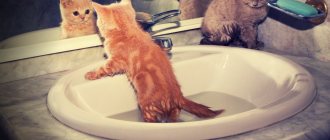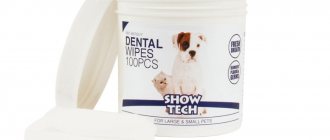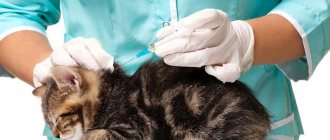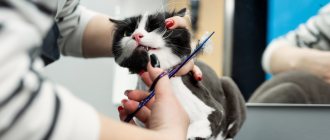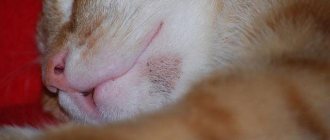Feasibility of the procedure
The kitten cannot clean its ears on its own, so it needs help. Dirty ears cause the development of an inflammatory process, so you need to systematically monitor the condition of the ears and take all necessary measures in a timely manner.
When cleaning is necessary
The procedure should be carried out once every 2-4 months. The frequency depends on the breed of the pet. For example, the ear shell of sphinxes gets dirty much faster. It should be cleaned 1-2 times a week .
A similar situation is observed among Rexes, Abyssinians, and Siamese. They undergo hygiene measures weekly.
The procedure is carried out in the following cases:
- dusty deposits, dirt;
- brown, black dots, spots;
- dry crusts of dark color;
- discharge of pus;
- excess sulfur;
- dried blood, scratching;
- unpleasant odor;
- the pet shakes its head, scratches the area behind the ears.
Inspection of the ears is carried out daily, and cleaning as they become dirty.
Ear cleaning at the veterinary clinic
In any veterinary clinic, professional ear cleaning is included in the list of basic services provided. To carry out this procedure for the first time, it is advisable to seek help from a veterinarian, who will explain the technology in detail, show everything clearly and give the necessary recommendations . Then you can perform all the manipulations yourself.
You can have your cat's ears professionally cleaned at your veterinary clinic.
Veterinarians advise owners of expensive elite animals that require more frequent and thorough cleanings (loose-eared animals, sphinxes, etc.) to contact a veterinary clinic approximately once a month for ear cleaning.
Features of the procedure
There is an opinion that cotton swabs should not be used. This method is traumatic, so it is recommended to resort to an alternative option: you can also clean the ear from dirt and secretions with water, but you need to wash the baby carefully so as not to scare it.
Safety regulations
Before performing the procedure, you should learn how to properly clean your pet’s ears from dirt.
The following manipulations are performed:
- The animal is wrapped in a towel.
- The ear is carefully bent outward, and the curves of the inner part become clearly visible.
- A cotton pad is moistened in a special product.
- Carefully wipe the inside.
- If necessary, such actions are repeated, but with a clean disk.
- Moisten the cotton swab. Clean the bends from the inside to the outside, otherwise the dirt may push deeper, and this can lead to inflammation.
Owners are often afraid that the animal's eardrum may be damaged when performing such actions. But you shouldn’t be afraid of this: kittens have a bend in the ear canal that does not allow deeper cleaning of the ear.
There is a risk of damage to delicate skin, but this happens if hard sticks are used or the actions are performed carelessly.
When dirt in the ears is an indicator of disease
Sometimes dirty ears are an indicator of a disease. Contacting a veterinary clinic may be required if:
- ears get dirty within a few days after hygiene procedures;
- a lot of wax is produced in the ear canal;
- purulent discharge does not stop;
- At the same time, the cat is restless, itches often, leaving scratches, and shakes its head.
Such symptoms occur with otitis media of any severity or when the ear canal is damaged by ear mites. Accurate diagnosis is carried out in a veterinary clinic. The earlier treatment is started, the more effective it is, and the less the animal suffers.
If left untreated, your pet may experience deafness. In addition, the ear contains the vestibular apparatus, which is responsible for balance. If your cat has ear diseases, he or she may experience dizziness and nausea.
Drops are used to treat ear diseases. In some cases, the veterinarian may prescribe antibacterial and anti-inflammatory drugs.
It is necessary to instill the medicine only after removing purulent discharge and sulfur, otherwise the effect of the drug will not be effective. The cleansing procedure is carried out in the same way as for healthy cats, but instead of a special cleansing gel, the doctor may recommend hydrogen peroxide or chlorhexidine. After recovery, they should not be used. They cause the delicate skin on the inside of the ears to dry out and peel. For the same reason, you should not use products containing alcohol.
Necessary materials
To properly clean your pet’s ears at home, you must first stock up on all the necessary materials.
You will need:
- cotton swab or swabs;
- baby wipes (you can use a cotton pad instead);
- towel;
- nylon muzzle (needed for an aggressive animal).
Caring for a Briton
Caring for Britons involves keeping their coat, ears, claws, eyes and teeth in order.
Wool
Since we are talking about domestic cats that do not freeze and hardly suffer from heat, the shedding process is not seasonal. The wool is replaced little by little and gradually. I consider grooming to be the most important, since the plush, shiny coat is the “calling card” of the British. Her condition is largely determined by proper nutrition . Vitamin supplements also play an important role. I use brewer's yeast, as well as wool removal paste. Be sure to keep in mind that these vitamin supplements affect the intensity of coat pigmentation, as do carrots and seaweed, which are also often found in foods and vitamins. If for black and chocolate British cats this will help to intensify and enhance the brightness of the color, then in British cats of light colors, such as blue, lilac, fawn and cream British cats, the use of these vitamin supplements will lead to a darkening of the color, which may unpleasantly surprise the expert and you . Here I will talk about cleaning and combing wool. Cleaning consists of washing with water using a suitable special shampoo for cats (do not use human or toilet soap, we do not lick our hair, the shampoo must be safe for the cat's stomach) or using a talc-based dry shampoo sold in pet stores. I like the results of using professional cosmetics for cats from BIO-GROOM (USA), the shampoos do not irritate the mucous membrane of the eyes, wash the coat perfectly without removing the natural lubricating layer, without drying out the skin, and also help to enhance its growth (noted from my own experience) )). Regarding washing a cat, I can give some advice, dictated by the regular use of this procedure in relation to the small and adult inhabitants of my cattery. Preparation: shampoo, towel, comb, hair dryer, bathtub cover, rubber mat. The first water procedure awaits a small kitten a little over a month old. Since the child is small, it is most convenient to carry out the event in a sink that has a plug in the drain hole. I take warm water (about 32 degrees, although the kitten’s body temperature exceeds 38), slowly immerse the kitten in the water, wet it well and lather it with shampoo (it’s convenient to cover the ears with cotton swabs first so that water doesn’t get inside). For soaping, I place the kitten on a board on top of the bathtub, on which I place a rubber mat. This must be done carefully and very quickly, since the heat exchange of kittens is very intense, and a kitten covered with wet fur quickly freezes. I thoroughly rinse the kitten in the sink so that the baby does not break out, you can use the “mother’s grip”, i.e. lightly grab the kitten by the scruff of the neck with one hand, place the other under its paws so that it feels supported and is not afraid. At the same time, it is very good to constantly talk to the kitten so that he hears your gentle, calm voice and does not perceive bathing as an execution. Under no circumstances make noise at the kitten or frighten it with sudden movements. Fear acquired in childhood is very persistent; later, during this procedure, serious problems may arise when the animal grows up and is able to provide serious resistance. For a small kitten that has not yet had time to pick up dirt, it is enough to soap it once. But you need to rinse it in clean water so that the water freely surrounds the kitten on all sides (so that it swims freely in it), you need to do it 2-3 times. After this, wipe dry with a towel prepared in advance and dry with a hairdryer, combing the baby with a comb. Of course, he will hide and be afraid, but your calm, confident voice will keep him from panicking. I have had cases when a kitten happily exposed its belly to warm streams of air. To be fair, it should be noted that such behavior is the exception rather than the rule))
As for my adult animals (Ginny and Grisha), I have not accustomed them to this procedure since kitten age, as a result I have some problems with washing them in the bathroom. The cat is terrified of this room, and the cat doesn’t like it either. My animals taught me the following. You should not lower the cat to the bottom of the bathtub - it cannot see the room due to the high sides, it is frightened by the lack of information and the noise of water falling into the bathtub. Now I use an intermediate option: first I use Groomer's Goop degreasing paste (it is applied to dry fur, this procedure is especially important for a cat who, due to his special sexuality, has a “greasy tail”, the paste must be on the fur for at least 5 minutes to create the desired effect ), then I wash off the paste by pouring the animal sitting on the bathtub board out of the shower. Then follows soaping twice, followed by thorough rinsing with the same shower. It’s better to have an assistant who will keep the animal from migrating under the bath)) This, of course, is worse than rinsing the cat completely immersed in water, but I can’t get the consent of my pets for this, so I water them with a shower for quite a long time, rinsing and the tummy, and the armpits, and the tail, and under the tail. The bathroom should be closed in case the cat gets scared and breaks out and runs away. Wet, she risks getting sick. After the “bath”, dry it thoroughly with a towel. After the towel, I dry the cats with a hairdryer, not with hot air, but with warm air, so as not to burn them, although they are clearly not happy with this, but since I am the main cat in the pride, they can only accept it. You have to temporarily become a multi-armed goddess to hold the cat, hair dryer and comb, since combing the hair dries faster.
Dry shampoo is a fine powder called talc. It absorbs dirt and grease and rolls into pellets. To use it, you need to lightly comb the cat's fur against its growth, sprinkle shampoo on the fur and rub it into the fur with massaging movements. I use dry shampoo topically, most often for long-haired kittens, who quite often have problems with the cleanliness of their pants and shirtfront (related to food and the reverse process). After distributing the shampoo over the cat's body, you need to comb it out. Thus, we smoothly move on to the next care procedure - combing the fur.
For this procedure, you will need several types of combs - a single-row fine comb on the handle (a comb, when purchasing, be sure to pay attention to the quality of the ends, testing with your finger so that they are not sharp and do not have metal burrs), a massage comb with metal teeth, on the tips of which there are small balls (so as not to injure the skin) - preferably several sizes (large - for the back and sides, small - for the head, tail, abdomen, neck and armpits). And finally, a brush with natural or rubber bristles to “polish” the wool. I use the first two types of combs to comb my animals both against the grain and along it. The duration of the procedure cannot be determined. This will depend on the intensity of hair loss. You will know that the end is approaching by the decrease in the amount of hair remaining on the comb. After combing with combs, I take my furry friends to the bathroom and there I remove the remaining hair with wet hands. If you are going to have a reception where your tailed pets will be shown in front of the public, you can use lotion to make the coat shine by spraying the animal and polishing the coat with a bristle brush. Experts call proper coat care grooming. With its help, you can correct defects in the exterior (often found elongated hair along the back and at the base of the tail).
Eyes
Britons' eyes can run a little, especially in kittens. If the discharge is light and dry, carefully remove it with a cotton swab or sterile cloth. To care for the eyes of cats, pet stores have a large selection of herbal lotions (Phytoelite series). “Chamomile” is used for dark discharge associated with inflammation of the mucous membrane, “Calendula” can be used for excessive lacrimation, for daily hygiene care you can choose “Green tea” or “Sage”. Never reach into a cat’s eye with unwashed hands while walking around to quickly pick off a dark speck. This can provoke a serious inflammatory process. Under no circumstances should you rush to use potent drugs. If the condition of your pet's eyes bothers you, you need to start with a well-known antiviral agent - human interferon, dissolve and drop 1-2 drops into the eyes and nose every 3-4 hours. If after three days the result is not noticeable, you can switch to the veterinary drug “Diamond Eyes”. If this does not help, contact your veterinarian, perhaps he will recommend antibiotics such as Levomecithin eye drops, Erythromycin or Tetracycline ointment. When using these medications, remember that the effectiveness of the antibiotic depends on the regimen you take the medication. And only if no other means have helped, hormonal pills and ointments are used as the last line of defense, never prescribe anything like that to your pet.
It should be noted that persistent eye problems may be a sign of some more serious disease. There are infections that have a detrimental effect on the immune system ( coronavirus , for example), and eye inflammation can be the result of a secondary infection, from which the body cannot protect itself due to weakened immunity.
Claws
Periodically (about once every 2-3 weeks) it is necessary to trim the claws on the front paws (on the hind paws you can only trim them once a month, they grow slowly). For trimming claws, use human nail clippers or special cat claw scissors, which can be purchased at a pet store. It must be taken into account that there is a blood vessel in the claw; it can be seen through the light. To access the claw, you need to sit the kitten on your lap, take the paw, lightly press the pad of your finger, and the claw will appear. Trim 1.5-2.5 mm perpendicular to the nail. Don't expect much understanding. The procedure does not bring pleasure, you can only achieve tolerance.
Don't damage the blood vessel! If this happens, disinfect as usual (for example, chlorhexidine or hydrogen peroxide). Note that the front paws have high toes. Don't forget about them.
A special scratching post is absolutely necessary for caring for claws. The cat's claw is renewed due to the desquamation of thin plates from the underside of the claw, which the cat can get rid of only by scraping its claws along a dense and fairly loose surface. Pet stores sell separate scratching posts and scratching posts combined with a cat house for these purposes. When choosing, keep in mind that a board hung on one nail will not be successful, since the reliability and solidity of this device are needed. Either such a board is firmly attached to the wall with several screws (keep in mind when choosing a height that while sharpening its claws, the cat likes to stand up to its full height and stretch), or you buy a post covered with jute rope, high enough and stable. As a scratching post, the cat also likes to use rubber mats, which I, for example, are located near the litter tray and perform a double function - barriers from the spread of litter throughout the living quarters and a means for tidying up the claws.
Ears
If your cat actively exposes its ears to you for petting and scratching, it’s most likely time to rid it of wax deposits. Although my own experience suggests that frequent ear cleaning provokes more active earwax production. Therefore, here, as in any other matter, a golden mean is needed so that, on the one hand, the cat does not become overgrown with dirt, and on the other, does not torture her with these frequent and useless procedures, since the more and more often the ear is cleaned the sooner it needs this procedure again. To do this, I use a special ear product from the BIO-GROOM series (at worst, hydrogen peroxide will do) and cotton pads. I pour peroxide into a small saucer or rosette, moisten a disk divided into two parts (one for each ear) in peroxide, squeeze it thoroughly and warm it in my fingers. During all procedures, the animal is on my lap. I stretch half a cotton pad into a “handkerchief” and put it on the tip of my finger (do not carry out this procedure with long nails!). I begin to clean the cat's ear, starting with easily accessible areas. Sometimes sulfur impurities appear in the area in front of the ears, which is sparsely covered with hair, in the form of brown sticky formations. Then I move deeper into the ear and clean there as thoroughly as possible. The cat's ear has a very difficult terrain, so be extremely careful not to scratch the delicate skin. Movements should be neat, soft and gentle, and the voice persuading the cat to be patient a little should be gentle. If you do not hurt the cat, next time she will expose her ears to you herself. Sulfur accumulations cause discomfort in the cat, and she will be grateful for your help.
Teeth
It’s worth talking about teeth, quite often their care remains “behind the scenes”, although teeth are no less important for cats than for people, but cat dental prosthetics are not practiced in our country, so you need to try to preserve the health of your cat’s teeth as much as possible at all times years of her life. As you know, a cat at home does not have the opportunity to get its teeth in order - there are no suitable twigs and grass with which it could help itself clean the spaces between its teeth. One of my cats adapted a toy mouse on a spring for this purpose. Actually, not even a mouse, but a spring. Oddly enough, she is quite successful in this procedure of cleaning her teeth with the help of such a means under her paws, and this particular cat does not have stones on her teeth, and neither does she have plaque. Every day she chews this spring for 15-20 minutes, moving it between her teeth. Among the specialized products on sale, there are toothbrushes and teeth-cleaning compositions (sets), and often the brush has the form of a cap that is put on the finger. The devices are not very convenient, they are often too large for a cat’s mouth, and not every cat will agree to such a procedure. Many manufacturers of professional food have food for removing dental plaque in their product range. It should be noted that any dry food has a cleaning effect due to the abrasive property of solid food, when when the cat chews it, it mechanically removes plaque from the tooth. Specialized foods are made in such a way that they release active substances into the saliva that help dissolve plaque. If your cat eats ready-made food, it makes sense to regularly give her special food to eliminate plaque. If the situation is advanced, and not only plaque, but also tartar has formed on the teeth, then you will have to perform a special procedure at the veterinarian to remove tartar. The bad news is that most often this procedure is performed under general anesthesia, which does not help improve the cat’s health. If you have very close contact with your cat, she completely trusts you, will allow you to perform the procedure of removing the stone, which is quite painful for her, you can do it yourself, without resorting to the help of a specialist.
You need to arm yourself with special tools, very similar to the tools of human dentists. You can buy these devices at some veterinary pharmacies. Dental pickers for cats are broadly divided into two types - the actual pickers, which have the shape of a pointed hook, which need to be operated BETWEEN the teeth, and the spatula, which is used to remove large stones from the surface of the tooth itself, usually this applies to large molars growing in the depths mouth at the jaw closure. Sometimes, to carry out the procedure, the cat’s persuasion is enough for me; I mechanically clean the stones from the teeth and between them, when the event is completed, I wipe the dentition with a well-wrung out cotton pad soaked in hydrogen peroxide. It disinfects scratches on the gums that will inevitably occur and removes plaque. But sometimes you have to swaddle the client so that his actions do not interfere with turning a cat’s grin into a Hollywood smile. Advice. If you take on a task, do not try to finish it in one go. Let the cat come to its senses, and it wouldn’t hurt for you to get distracted either. If the entire jaw is put in order in a week, it is still better than traumatizing the cat’s psyche with a visit to the veterinarian, where she will be given anesthesia, which affects both the health of blood vessels and the liver.
Deeply soiled cleaning
You can clean deep dirt as follows:
- The kitten is fixed in a comfortable position.
- A special product is instilled into the ear.
- The ear is gently massaged in the lower part - this way the drug is distributed evenly throughout the entire inner part.
- The animal is released so that the pet can shake its head.
- The kitten is picked up again, the cotton swab is immersed deeper, removing dirt
- Additionally, cleaning is carried out using a cotton pad.
- Similar manipulations are performed with the second ear.
Should cats' ears be cleaned?
Animals that do not leave the house do not require regular ear care. Little sulfur is produced, and they get sick less often. With frequent cleaning, secretion increases, increasing the risk of plugs. To keep your ears healthy, you can occasionally clean the shell and top of the passage.
The exception is animals that do not have hair (Levy, Sphinx, Peterbald, Elf, Cojona). Sparse hairs on the inner surfaces of the ear cavities do not protect well from dirt, and wax is produced more intensively. Ears quickly become dirty and require regular cleaning.
In breeds with large ears (Abyssinians, Maine Coons, Somalis, Rexes, Orientals, Savannahs), dirt also accumulates quickly. Cleaning is required weekly. However, it is better to focus on the inspection results. It happens that some animals keep their ears clean for a long time.
When sulfur accumulates, fungi and harmful microorganisms multiply, immunity decreases, and diseases caused by ear mites develop. Most often this happens to individuals of lop-eared breeds who are unable to wash their ears on their own.
Treatment is carried out once every 1-2 weeks. But do not overdo it; a lack of sulfur also contributes to the development of certain diseases.
If there is a lot of dirt and sulfur, the pollution accumulates too quickly, you need to show the animal to a veterinarian. It may happen that the cat is sick and needs medication. In such a situation, ear cleaning becomes an auxiliary procedure. The cause is eliminated by treatment.
Overview of allowed funds
Read the instructions carefully: the product should be intended specifically for cleaning, and should not contain anti-inflammatory components.
It is allowed to use drugs for dogs.
For these purposes the following are assigned:
- Doctor Vic. Lotion made in Belarus. Used to soften sulfur before cleaning or treatment.
- EAR cleaner. The drug is produced in the United States of America. It contains aloe and lanolin. The components help eliminate itching and relieve irritation.
- Leopard. Domestic product. The lotion is an alcohol solution of dimethyl sulfoxide with glycerin.
- Aurocline. The drug is made in Italy. Contains chamomile extract. Helps soften sulfur.
If it is impossible to purchase special products, you can use saline solution and heated olive oil.
Washing is unacceptable:
- chlorhexidine;
- alcohol-containing preparations;
- soap solutions;
- hydrogen peroxide.
Uses of hydrogen peroxide
The use of hydrogen peroxide is strictly prohibited . The product causes the skin in the ear canal to dry out. The formation of ulcerations and cracks is noted. Such changes lead to deterioration.
Features of the structure of the auricle
Cats' ears detect sounds in the range of 20-100 00 Hz. Cartilage and muscles rotate the shells, which makes it possible to accurately determine the source of the noise. This feature is important when hunting.
Cats' ears have three parts:
- external with the auditory canal (the shell is in the shape of a funnel, the internal surfaces are covered with guard hairs, the external ones are covered with wool);
- the middle one consists of the tympanic cavity with three auditory ossicles and an membrane;
- internal (the most complex) in the form of a hollow bone formation located in the temple area.
Vestibular and auditory receptors are located inside (in the third part).
The auditory canal of cats is located at an angle and bends. This must be taken into account when cleaning, otherwise there is a risk of wax plug formation.
Rules for cleaning ticks
Ear mites live in the ear canal and feed on skin cells. It is impossible to see the parasite with the naked eye. Only the products of its vital activity are clearly visible (dirty dark brown flakes).
The symptoms of the lesion are as follows:
- restless behavior;
- the pet shakes its head, scratches its ear, scratches it until it bleeds;
- rubs his head against interior items;
- an unpleasant odor appears;
- the presence of dark crusts is noted;
- hearing problems arise.
Such changes cannot be ignored. Special means are used. The drug Bars is considered the most affordable.
The ear is treated as follows:
- The pet is wrapped in a towel and placed on your lap. He should be stroked and calmed down.
- The auricle is turned out. The kitten is securely restrained.
- Wipe the inner surface with a moistened cotton swab.
- Use a cotton swab to go along the curves, without bringing it into the ear canal.
After removing the plaque, they begin to get rid of the mites: take a cotton swab, moisten it in the product and gently wipe the ear canal (the swab is not inserted too deeply).
These actions are performed daily for 2 weeks. The medicine is instilled into the ear every 4 times. It is important that the kitten does not shake its head, otherwise the drug will spill out.
The most common ear problems
A visual examination of the ears of cats can detect several diseases. The symptoms they experience are different.
Ear mite
The most common disease in cats is otodecosis (ear scabies), which is caused by ear mites. This parasite lives in the ear canal and feeds on epithelial cells. It is impossible to see it with the naked eye due to its microscopic size, but traces of its vital activity are clearly visible.
Ear mites cannot be seen with the naked eye.
The symptoms of the disease are as follows:
- the cat behaves restlessly, often shakes its head and rubs it against the furniture;
- furiously scratches his ears with his hind paws, sometimes scratching them until they bleed;
- ears smell unpleasant;
- Inside the ear you can see dark brown crumbly plaque and crusts.
In advanced cases of otodecosis, hearing may deteriorate.
Cats are most often affected by ear mites.
For advice, please contact a veterinary clinic. The specialist will prescribe the necessary medication to treat this disease. Be sure to thoroughly wash your cat’s ears every day, using specialized care products (Leopard, etc.). The solution may sting the skin slightly, so you will need to hold your pet tightly, wrapped in a cloth. After cleaning, drops prescribed by the veterinarian are placed as deep as possible into the passage. To prevent the cat from shaking its head after this, you need to press its ears and hold it there for several minutes. Otherwise, the animal will simply shake the medicine out.
When infected with ear mites, it is recommended to use specialized preparations
From personal experience. We picked up the previous cat on the street in an extremely dirty and neglected condition. When they washed it and dried it, it turned out that the ears were full of dark plaque. Although he was not wild, he endured the washing procedure with great difficulty. We fought the tick for a very long time, the degree of damage was high. At the same time, the cat constantly jerked and shook its head, sometimes hitting it on the floor and furniture. He scratched the skin in his ears until he bled. Then throughout my life I had to periodically instill medicinal drugs. If you forget a little, the tick will immediately show up again.
Otitis
Inflammation of the external auditory canal caused by bacteria or yeast is called otitis media.
The disease is expressed by the following symptoms:
- purulent discharge with an unpleasant odor comes out of the ear;
- the animal is worried and periodically shakes its head;
- redness and swelling are observed on the ear mucosa;
- the cat presses and scratches his ears, while meowing very pitifully (it is clear that he is in pain).
With otitis media, the cat behaves restlessly
If you have these symptoms, you should immediately contact a veterinary clinic to receive qualified treatment.
With otitis externa, pus is discharged from the ear
Self-medication for any form of otitis in a cat is strictly contraindicated. The inflammatory process can spread to the inner ear, and from there to the meninges. This is extremely dangerous.
Ear hematomas
If a cat shakes its head too intensely or scratches its ears violently, blood vessels burst and bruises form. They appear as multiple small brown spots of coagulated blood between the shell cartilage and the skin. This behavior may be the result of flea or ear mite infestation, and may also be caused by an infection (otitis media) or allergies.
A hematoma in a cat’s ear does not require special treatment.
No special treatment for hematoma is required; it is necessary to deal with the underlying problem.
Solar dermatitis
Cats that lack melanin (albinos), hairless animals, and those with white ears are susceptible to sunburn. The auricle first turns red, then hair falls out along the edge, the skin thickens and itches very much. Due to multiple scratches, there is a risk of infection with infectious diseases. Untreated dermatitis can lead to the development of cancer.
White cats are more susceptible to solar dermatitis
Squamous cell carcinoma
Malignant skin tumors (carcinoma) are sometimes found in cats. This type of growth is usually the result of exposure to excess sunlight. It can affect various areas of the skin, but most often appears on the ears. It manifests itself in the form of long-lasting red spots, seals, hair loss and slow-healing ulcers.
Squamous cell carcinoma is sometimes found in white cats
Frostbite
Exposure to extreme cold destroys ear tissue. First, the skin becomes discolored, then turns red, and later turns black and peels.
From personal experience. When we bought our house, we inherited a tabby cat. Despite frosts of -40°C, he constantly walked outside. He only came home to eat. The cat had almost no ears, only small stumps remained in place of the ears. His previous owner was an old woman and did not treat her pet at all. The wounds simply became painful and healed.
Extreme cold can damage your ears
If you have any suspicious symptoms, you should consult a veterinarian. Only he will be able to prescribe competent treatment and help avoid serious consequences for the pet’s health.
Security measures
To minimize the risk of damage, it is recommended that the procedure be carried out by two people: one person will hold the kitten, and the second will perform the hygiene procedure.
Before doing this, it would be a good idea to trim the animal’s claws or use special anti-scratch guards.
Before starting the main actions, prepare all the equipment. The pet is wrapped in a towel and calmed down.
Ear examination
In order to detect and treat ear disease in a timely manner, examinations are carried out weekly.
A healthy cat's ears are clean, warm, and slightly oily to the touch. If the animal is released from home, inspection is carried out daily. A cat can get ticks, and sometimes its ears are injured during a fight. The ingress of foreign objects cannot be completely excluded.
The inspection is simple. It is necessary to bend the sink and inspect the inner surface. To better see nooks and crannies, you can use a flashlight.
How to prepare your cat for the procedure
You should accustom your cat to the procedure of cleaning his ears from childhood, otherwise it may turn into a “circus on the road” for you. Cats have a phenomenal memory for such things, and if the procedure is unpleasant, in the future the kitty will resist it with double force.
But cleaning your cat’s ears is not only possible, but also necessary.
General tips for preparing your cat for cleaning:
- Do not frighten the animal, first calm it down using the usual methods: play, affection, stroke your favorite place. It will be good if he starts to fall asleep.
- Carry out an inspection, to do this, just “wrap” them, there is no need to get creative and tear off the cat’s ears, trying to look at something.
- If it is basically impossible to calm the cat, then the old fashioned method will do - a towel and strong hands.
The procedure does not require complex preparation and boils down to calming or pacifying the animal.
What is strictly prohibited
Veterinarians often encounter negligence from owners who want to wash or wipe their cat’s ears free of dirt. Do not repeat the mistakes of others, it is strictly prohibited:
- Use alcohol and vodka to clean delicate cat ears.
- Use a sharp object to remove any dirt or stuck-on earwax.
- It is better not to use hydrogen peroxide: it irritates the delicate skin of the cat.
- Clean with medications, incl. chlorhexidine, only as prescribed by a doctor: the cat may be allergic.
- Even if the cat tolerates bathing, it is forbidden to wash its ears with soapy water.
To avoid making a fatal mistake, show your pet to a veterinarian before cleaning and listen to his recommendations. Inspection and consultation costs symbolic money.
Take time to cleanse in the evening
At work or at university, it is difficult to clean your teeth efficiently, so once or twice a day you need to do a thorough cleaning using brushes. Each brush must be placed under the arch and the interdental spaces and the space under the arch must be cleaned. But this is only relevant for those who wear braces.
To clean braces, a brush with a brush is useful; when treating aligners, a regular or electric brush is sufficient.
It’s easier with aligners: you can brush your teeth with an ultrasonic electric toothbrush. They often have a timer that measures the required 2 minutes. To make sure that your teeth are clean, you can use an elixir with the function of “revealing” plaque - as a rule, after such a rinse, you have to brush your teeth again.
For convenience and comfort, all orthodontic patients can have an irrigator at home - a device that cleans teeth with a thin stream of water under pressure. Water literally “knocks out” all the remaining food from hard-to-reach places and massages the gums, which is useful not only during orthodontic treatment, but in general always.
An irrigator helps keep your teeth perfectly clean
How to clean a kitten's ears
First of all, it is worth noting that ear contamination in kittens most often appears only in the presence of diseases, but there are always exceptions. You can clean kittens' ears using exactly the same techniques and materials as adult cats. Veterinarians recommend washing their ears with special solutions - this way you can protect the fragile and delicate auditory system from unnecessary stress and interference. It's time to use training techniques and teach him to enjoy hygiene procedures. Let him regard this as a kind of game, for participation in which he receives a reward - a treat and affection.
The rinsing procedure is simple - 4-5 drops of the product are placed in the ear canal, then you need to wait 1-2 minutes, and then repeat the procedure. During the process, the kitten may behave unnaturally, for example, shake its head and even meow - don’t be afraid, this is a normal reaction.
What symptoms should you be wary of?
The fact that inflammation begins is indicated by:
- redness of the skin;
- increased temperature around the ears;
- narrowing of the canal due to a tumor;
- lightening/darkening of sulfur;
- squelching sound when pressed;
- discharge containing blood;
- unpleasant odor;
- too much sulfur;
- the presence of pus, fluid;
- hearing loss.
If a cat is sick, its behavior changes. The animal shakes its head, bends left and right, and often itches. When you touch the ear, the cat flinches and runs away.
Useful video No. 2: cleaning the ears of an adult cat
Source

